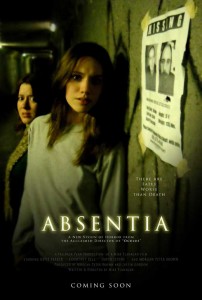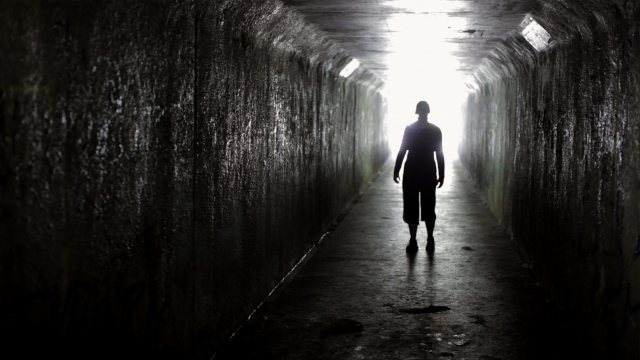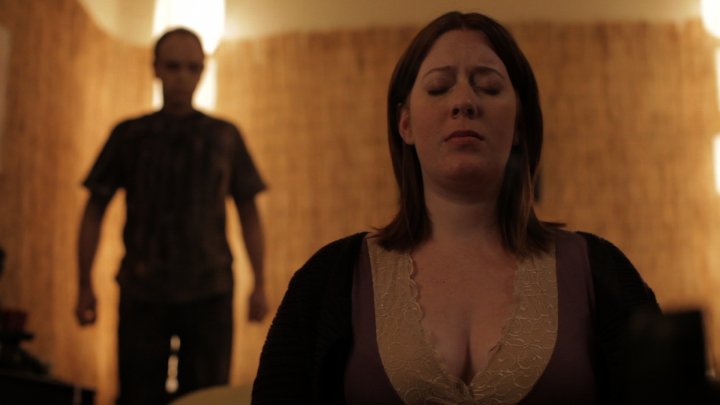Grief and Guilt in Mike Flanagan’s “ABSENTIA”
Stranger Things Have Happened… Grief and Guilt in Mike Flanagan’s ABSENTIA
Interview by Kier-La Janisse
———————
 Writer/director Mike Flanagan first burst onto the scene with the 32-minute Oculus (unconventionally long for a short film) in 2006, and took the fest circuit by surprise with this terrifying horror film that essentially takes place entirely in one room, with one character and a mirror. We expected great things from him after Oculus, and now he’s back with his first feature, arguably the most chilling and effectively scary of this year’s horror offerings. Centered on a pregnant woman whose husband mysteriously disappeared, and her relationship with the long-absent drug-addled sister who has returned equally mysteriously, Absentia blends fantastic characterization with urban legends and to create one of the most compelling horror films we’ve seen in ages. Mike Flanagan, who will be hosting his Canadian Premiere screening at Fantasia on July 28th, sat down for an interview with Spectacular Optical about guilt, canadain cialis loss, urban legends and why his film is so great at getting under your skin.
Writer/director Mike Flanagan first burst onto the scene with the 32-minute Oculus (unconventionally long for a short film) in 2006, and took the fest circuit by surprise with this terrifying horror film that essentially takes place entirely in one room, with one character and a mirror. We expected great things from him after Oculus, and now he’s back with his first feature, arguably the most chilling and effectively scary of this year’s horror offerings. Centered on a pregnant woman whose husband mysteriously disappeared, and her relationship with the long-absent drug-addled sister who has returned equally mysteriously, Absentia blends fantastic characterization with urban legends and to create one of the most compelling horror films we’ve seen in ages. Mike Flanagan, who will be hosting his Canadian Premiere screening at Fantasia on July 28th, sat down for an interview with Spectacular Optical about guilt, canadain cialis loss, urban legends and why his film is so great at getting under your skin.
———————-
Is generic viagra online uk it based on any real urban myths or disappearances?
There are several urban myths that helped this along. I really liked the story of Jackson Wright, who was driving from New York to New Jersey in 1975 via the Lincoln Tunnel. Once through the tunnel he stopped best online generic levitra the car to clear the windshield of condensation. His wife Martha hopped out, offering to wipe off the back window. She just vanished, leaving a single handprint on the glass. No noise, no signs viagra super active of foul play, just gone.
That and a lot of the Scandinavian Vinterfolk troll legends, in which people would be spirited away and found wandering the woods twenty years later, showing signs of abuse. Creepy stuff.
You sidestep a lot of the exposition, when supernatural events occur, you cut away from the event itself and then later when characters are recounting it, you cut away from their verbal exposition as well. Can you tell me about this structure and why it appealed to you?
The idea was to cut away from the event itself, and then see it as recounted through a character’s eyes, which meant it left room for doubt as to whether we were seeing what actually happened or not. I love ambiguity. In this case, we’d already established that the movie would visually depict fantasies and thoughts that a character would be having, so it meant we could never really trust what we saw. When Callie is telling the police about what happened, they aren’t so sure they believe her, and hopefully neither are we.
Why the decision to have the ‘monster’ and the historical elements of the supernatural events be such a minor element of the story?
This was primarily a story about two sisters dealing with an unexplainable loss, and I always that to be the focus. We had no money, so I knew we couldn’t create a convincing and frightening monster on screen, but even if we’d had a big budget I doubt you’d see much more than you do. What you don’t see is always scarier than what you do see, and it was so challenging to try to paint a picture of a terrifying creature in the viewer’s mind without actually showing it.
As for the historical elements, I’d actually written several more scenes that put it much more in the forefront, but when I was editing the movie I didn’t think they worked. It just felt like we were trying to explain so much, and it seemed more unsettling the less we revealed. That became the driving philosophy behind putting the film together, to give people little crumbs to go on and let the rest remain mysterious. I hope it’s scarier that way.
The cops always refer to their neighbourhood as a bad neighbourhood – where is it supposed to take place?
It’s supposed to be in Glendale, CA, where I live. The neighborhood really isn’t bad at all. I liked the idea of the neighborhood having a reputation, a nickname in the police station (though we never reveal what that nickname is). I loved the idea of a weird pocket outside of the city where things just disappear.
– Is the mirror in the therapist’s office the same one from Oculus? (on a tangential note: Why is Oculus referred to as Oculus 3 on imdb?)
It is indeed – and the therapist is Scott Graham, who starred in “Oculus”. That short film was subtitled “Chapter 3: The Man with the Plan” because it was originally supposed to be part of an anthology of short films about the haunted mirror. We’d outlined nine chapters, and that was #3, which was the only one we could afford to shoot at the time. Eventually the plans for the anthology were scrapped to make way for the feature version of “Oculus,” which goes into production very soon.
– The character of Trisha is especially great, such an unconventional lead but she really works as a haunted, guilt-ridden woman surrounded by tragedy. Where did you find her and how did you describe the character to her?
I’ve known Courtney Bell since college. We became a couple in 2008 and started working together (we’ve been co-directing a documentary about marriage for the last two years). I knew I wanted her to star in this movie and it was very important that both the female leads be unconventional, smart, and different. What really took things to another level was her pregnancy, which we found out about just before I started working on the script.
She’s actually six months pregnant with our son Rigby in the movie, and when we decided to incorporate the pregnancy into the story it took Tricia to whole other place. She and Katie Parker, who plays Callie, are actually great friends and have a very sisterly relationship as it is, so they very easily inserted that chemistry into their onscreen relationship.
There seems to be a parallel created between the missing husband and the prodigal sister. Can you comment on this?
MINOR SPOILERS: There certainly is. Both are people who have disappeared from Tricia’s life into a dark place, either metaphorically or literally, only to reappear at her doorstep. In different ways, both have been to hell and back. Some people have even asked me if Callie was taken by the same creature and simply doesn’t remember it, as it appears that she’s the only person Daniel actively seems to remember when he’s back, and the only person he chooses to share any real information with. I don’t necessarily agree with that, though I think it’s terrific that such explanations can be made and still work within the framework of the story. Rather, I think lost souls share a kinship, and tend to recognize each other when they pass by.
– Both Trisha and the cop make declarations about not holding people’s escapes against them. And the repeated filing of a missing persons report is a nice touch. In a way it really shifts the perspective on who the victims of crimes really are by showing the devastation of the people left behind. I thought this was kind of amazing – what inspired this level of emotional depth in the film?
A truly beloved family member committed suicide shortly after I began working on the idea for the movie. Seeing the devastating effect it had on his immediate and extended family was horribly profound for me, and I recognize now how much that colored the movie. I think I was clearly processing ideas of grief, loss, anger and forgiveness while I was working on this script, and it’s striking to me now how embedded those themes are.
I think it’s important for horror to be “about” something more than scares, and hope that there’s always something of depth to explore. The genre elements are fun, to be sure, but I don’t truly get excited about a project unless it is about something more. I remember being bowled over the first time I saw Romero’s early work and realized “oh my god, he’s actually talking about racism!” and “he’s talking about consumerism!” I was amazed that horror movies could do that, and those are the kinds of films I want to make for the rest of my career if I can.
-What is your own personal view of therapy? It seems ambiguous in the film. The film could be seen as critical of therapy, but at the same time Trisha is the most grounded of all the characters, possibly because of her therapy.
I actually think therapy is terrific. I think people should be required to be in therapy every few years, whether they think they need it or not. I’ve always found it so cleansing, and truly don’t understand the stigma that is often associated with it. Tricia is doing well, I think, and I also really believe in the power of meditation (which some people call prayer, but it’s all the same thing; just communing with yourself).
That said, I do think Tricia’s therapist is of little help to her in dealing with the supernatural creature problem, but that’s clearly not his specialty.
Tell me about the kickstarter funding – how much of the film was funded through kickstarter? Do you think kickstarter has a limited lifespan before it gets too saturated?
About a third of the film was funded through Kickstarter. We got on the site in its infancy, in fact it was just out of BETA testing when we launched our campaign. I think its absolutely over-saturated now, and am pretty confident that we represent a minority within the Kickstarter world because we actually completed our film. I’ve backed other projects on the site and none have actually gone into production. It’s a mixed bag, to be sure. I think we did it at just the right time, before it became a “friendship tax” that pops up on your Facebook feed every few days.
I’m very grateful to Kickstarter for what it did for us, but think it’ll become problematic soon. Too many people who have no business making movies are using the site, and conversely, now professionals who don’t really “need” Kickstarter are putting projects up. I don’t plan to ever use crowd-funding again on my projects, I think you only get to dip into that well once … but I find I’m reluctant to back projects now as well.
There was horror film on the site that was very popular when we started our drive. I donated to support it. They were seeking about the same amount of money that we were and on the same timeframe. I just got an email from them last week updating me, and a year and a half later they’re still “location scouting”. As far as I know, I have no recourse to get that money back, but I remember shaking my head when I read that email and thinking “projects like this will eventually kill Kickstarter.”
——————–
ABSENTIA has its Canadian premiere on July 28th at 9:45pm hosted by Writer/Director/Producer Mike Flanagan and Producers Justin Gordon and Morgan Peter Brown. It screens again on July 29th at 2:20pm and August 7th at 9:30pm, all in the Salle JA DeSeve. Full details on the film page HERE.

 July 28, 2011
July 28, 2011  No Comments
No Comments




